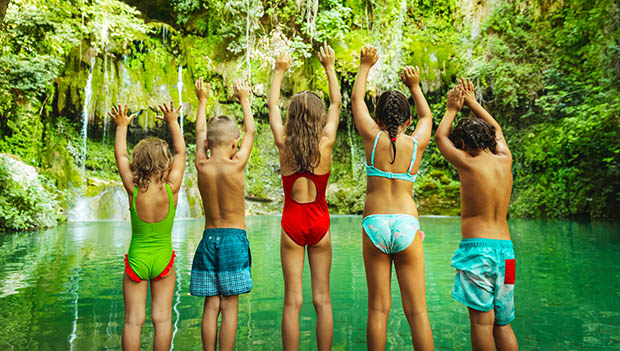
One of the best parts of summer is seeking out hidden swimming holes, jumping in the river on a hot day or cooling off in the lake while boating. But 90% of drownings happen in fresh water— and swimming in natural bodies of water comes with certain dangers that don’t exist in swimming pools. Before you dive in, here’s what you need to know about safely swimming in natural bodies of water.
Be Aware of the Current
That lazy river or creek sure looks inviting on a hot day. And while it may appear to move at a leisurely speed, looks can be deceiving. Test the water first before diving in to make sure that the pull of the current isn’t stronger than you anticipated.
If you enter a body of water and suddenly find yourself caught in a strong current, don’t try to swim against it—you’ll just tire yourself out. Instead, go with the current, swimming toward a side that will eventually lead you to shore.
If you’re swept away by a current and the body of water you’re in has a lot of hazardous debris, like logs and rocks, put your feet out in front of you to protect your head. When you’ve reached a safer stretch of water, gradually swim to shore.
Beware of Submerged Hazards
When you jump into a swimming pool, you can usually tell that the water is free of hazards. But that’s not the case when you enter dark bodies of water. You should never jump into an unknown body of water, even popular plunge pools, without knowing for sure that it is clear of submerged hazards like rocks, stumps and logs.
Submerged hazards can also create an eddy. Eddies are formed when water rushes around an obstacle, causing the water to circulate and create a reverse current. When that reverse current is strong enough, a whirlpool can form. Keep an eye out for circulating water, and avoid it at all costs.
Know the Potential for Drop-offs and Slippery Rocks
When you swim in natural bodies of water, you may be wading in water waist-deep one minute and the next you’re in over your head—literally. Every natural body of water has the potential for hidden drop-offs that can catch you off guard, so be aware that there’s a chance you may find yourself in deep water. If you aren’t a strong swimmer or don’t feel confident in the water you’re in, find another place to swim.
On a similar note, be aware that rocks in creeks, lakes and rivers are often very slippery and can cause you to lose your footing and fall. Trekking poles can help you keep your balance while wading through a body of water, and swim shoes or hiking sandals are also helpful tools to keep you on your feet.
Know If the Water Is Clean and Healthy
Your local swimming pool is infused with chemicals that control harmful bacteria in the water, but that’s not the case when it comes to natural waterways. Swimming in natural bodies of water with poor water quality can actually make you sick, so check the water quality before you swim to make sure you can swim safely. If you aren’t sure how to determine if your local waterway is safe, visit EPA.gov/MyWaterway.
Pay Attention to the Weather
If lightening strikes nearby while you’re swimming in a pool, you can be out of the water in a flash. But if you’re swimming in a natural body of water, you may have hiked for miles to get there or your boat may be anchored in the middle of a lake or river; it will take some time to reach safety.
Before you head out to your local swimming hole, check the weather to make sure the forecast is clear. Even if sunny skies are predicted, know that weather can change in an instant, so have a plan in case storms roll in.
Flash floods are the deadliest type of flood worldwide and can be a problem in some areas. Flash floods are hard to prepare for but if you’re in an area that experiences them frequently, local authorities will often post the flash flood potential every day. Pay attention, and if the likelihood of flash floods is high, save your swim for another day.
Wear a Life Jacket
Life jackets save lives and you should always wear one when swimming in a natural body of water. In fact, statistics show that life jackets could have saved the lives of over 80 percent of boating fatality victims. Before you head out for a swim in your favorite lake or river, grab your life jacket and wear it at all times when you are in the water.
READ THIS NEXT: Important Swim Safety Tips to Remember This Summer









Discuss This Article